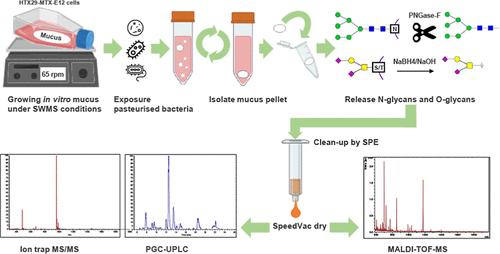当前位置:
X-MOL 学术
›
J. Agric. Food Chem.
›
论文详情
Our official English website, www.x-mol.net, welcomes your feedback! (Note: you will need to create a separate account there.)
Revealing Glycosylation Patterns in In Vitro-Produced Mucus Exposed to Pasteurized Mucus-Associated Intestinal Microbes by MALDI-TOF-MS and PGC-LC-MS/MS
Journal of Agricultural and Food Chemistry ( IF 5.7 ) Pub Date : 2024-06-26 , DOI: 10.1021/acs.jafc.4c01401 Carol de Ram 1 , Benthe van der Lugt 2 , Janneke Elzinga 3 , Sharon Geerlings 3 , Wilma T. Steegenga 2 , Clara Belzer 3 , Henk A. Schols 1
Journal of Agricultural and Food Chemistry ( IF 5.7 ) Pub Date : 2024-06-26 , DOI: 10.1021/acs.jafc.4c01401 Carol de Ram 1 , Benthe van der Lugt 2 , Janneke Elzinga 3 , Sharon Geerlings 3 , Wilma T. Steegenga 2 , Clara Belzer 3 , Henk A. Schols 1
Affiliation

|
The human intestinal mucus layer protects against pathogenic microorganisms and harmful substances, whereas it also provides an important colonization niche for mutualistic microbes. The main functional components of mucus are heavily glycosylated proteins, called mucins. Mucins can be cleaved and utilized by intestinal microbes. The mechanisms between intestinal microbes and the regulation of mucin glycosylation are still poorly understood. In this study, in vitro mucus was produced by HT29-MTX-E12 cells under Semi-Wet interface with Mechanical Stimulation. Cells were exposed to pasteurized nonpathogenic bacteria Akkermansia muciniphila, Ruminococcus gnavus, and Bacteroides fragilis to evaluate influence on glycosylation patterns. Following an optimized protocol, O- and N-glycans were efficiently and reproducibly released, identified, and semiquantified using MALDI-TOF-MS and PGC-LC-MS/MS. Exposure of cells to bacteria demonstrated increased diversity of sialylated O-glycans and increased abundance of high mannose N-glycans in in vitro produced mucus. Furthermore, changes in glycan ratios were observed. It is speculated that bacterial components interact with the enzymatic processes in glycan production and that pasteurized bacteria influence glycosyltransferases or genes involved. These results highlight the influence of pasteurized bacteria on glycosylation patterns, stress the intrinsic relationship between glycosylation and microbiota, and show the potential of using in vitro produced mucus to study glycosylation behavior.
中文翻译:

通过 MALDI-TOF-MS 和 PGC-LC-MS/MS 揭示暴露于巴氏灭菌粘液相关肠道微生物的体外产生的粘液的糖基化模式
人体肠道粘液层可以抵御病原微生物和有害物质,同时也为共生微生物提供了重要的定植生态位。粘液的主要功能成分是高度糖基化的蛋白质,称为粘蛋白。粘蛋白可以被肠道微生物裂解和利用。肠道微生物与粘蛋白糖基化调节之间的机制仍知之甚少。在本研究中,HT29-MTX-E12 细胞在半湿界面下通过机械刺激产生体外粘液。将细胞暴露于巴氏灭菌的非致病性细菌 Akkermansia muciniphila、瘤胃球菌和脆弱拟杆菌中,以评估对糖基化模式的影响。按照优化的方案,使用 MALDI-TOF-MS 和 PGC-LC-MS/MS 有效且可重复地释放、鉴定和半定量 O- 和 N-聚糖。将细胞暴露于细菌表明体外产生的粘液中唾液酸化 O-聚糖的多样性增加,并且高甘露糖 N-聚糖的丰度增加。此外,观察到聚糖比率的变化。据推测,细菌成分与聚糖生产中的酶促过程相互作用,并且巴氏灭菌细菌影响糖基转移酶或相关基因。这些结果强调了巴氏灭菌细菌对糖基化模式的影响,强调了糖基化与微生物群之间的内在关系,并显示了使用体外产生的粘液来研究糖基化行为的潜力。
更新日期:2024-06-26
中文翻译:

通过 MALDI-TOF-MS 和 PGC-LC-MS/MS 揭示暴露于巴氏灭菌粘液相关肠道微生物的体外产生的粘液的糖基化模式
人体肠道粘液层可以抵御病原微生物和有害物质,同时也为共生微生物提供了重要的定植生态位。粘液的主要功能成分是高度糖基化的蛋白质,称为粘蛋白。粘蛋白可以被肠道微生物裂解和利用。肠道微生物与粘蛋白糖基化调节之间的机制仍知之甚少。在本研究中,HT29-MTX-E12 细胞在半湿界面下通过机械刺激产生体外粘液。将细胞暴露于巴氏灭菌的非致病性细菌 Akkermansia muciniphila、瘤胃球菌和脆弱拟杆菌中,以评估对糖基化模式的影响。按照优化的方案,使用 MALDI-TOF-MS 和 PGC-LC-MS/MS 有效且可重复地释放、鉴定和半定量 O- 和 N-聚糖。将细胞暴露于细菌表明体外产生的粘液中唾液酸化 O-聚糖的多样性增加,并且高甘露糖 N-聚糖的丰度增加。此外,观察到聚糖比率的变化。据推测,细菌成分与聚糖生产中的酶促过程相互作用,并且巴氏灭菌细菌影响糖基转移酶或相关基因。这些结果强调了巴氏灭菌细菌对糖基化模式的影响,强调了糖基化与微生物群之间的内在关系,并显示了使用体外产生的粘液来研究糖基化行为的潜力。











































 京公网安备 11010802027423号
京公网安备 11010802027423号